Financial Management Report: Right Shares and Appraisal Techniques
VerifiedAdded on 2023/01/16
|15
|3725
|83
Report
AI Summary
This financial management report addresses key concepts through a detailed analysis of right shares, investment appraisal techniques, and scrip dividends. The report begins with an introduction to financial management, followed by calculations and analysis related to issuing right shares, including determination of theoretical ex-rights price, value of each right share, and fair value per right share under different scenarios. The report then provides a critical discussion of the advantages of scrip dividends for both the enterprise and shareholders. Furthermore, the report applies various investment appraisal techniques, such as payback period, NPV, ARR, and IRR, to evaluate a potential investment. It includes detailed calculations and a critical evaluation of the benefits and limitations of each technique. The analysis is supported by examples from Lexbel Plc and Lovewell Limited, providing practical insights into financial decision-making. The report concludes with a summary of the key findings and a list of references.

Financial
Management
Management
Paraphrase This Document
Need a fresh take? Get an instant paraphrase of this document with our AI Paraphraser
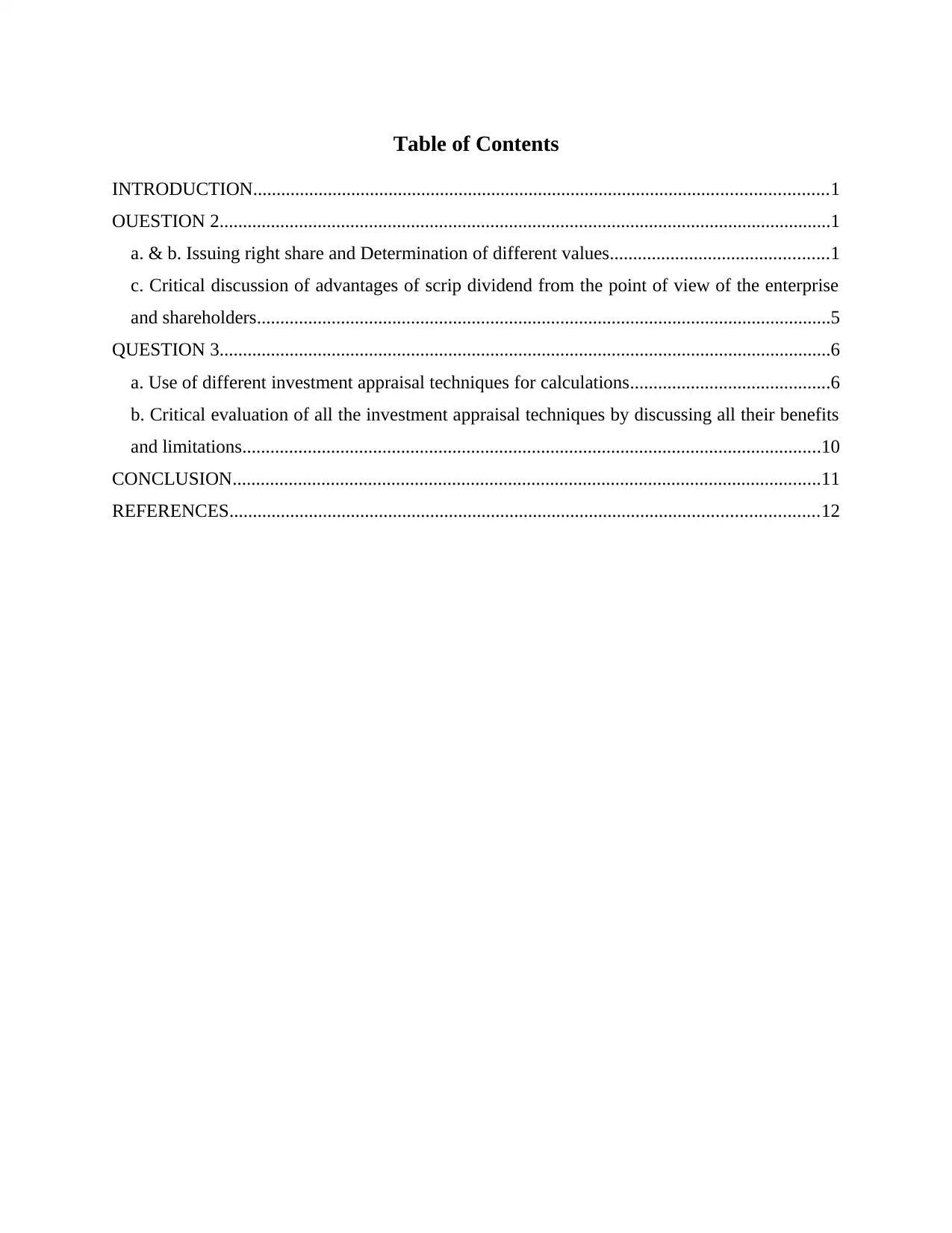
Table of Contents
INTRODUCTION...........................................................................................................................1
OUESTION 2...................................................................................................................................1
a. & b. Issuing right share and Determination of different values...............................................1
c. Critical discussion of advantages of scrip dividend from the point of view of the enterprise
and shareholders...........................................................................................................................5
QUESTION 3...................................................................................................................................6
a. Use of different investment appraisal techniques for calculations...........................................6
b. Critical evaluation of all the investment appraisal techniques by discussing all their benefits
and limitations............................................................................................................................10
CONCLUSION..............................................................................................................................11
REFERENCES..............................................................................................................................12
INTRODUCTION...........................................................................................................................1
OUESTION 2...................................................................................................................................1
a. & b. Issuing right share and Determination of different values...............................................1
c. Critical discussion of advantages of scrip dividend from the point of view of the enterprise
and shareholders...........................................................................................................................5
QUESTION 3...................................................................................................................................6
a. Use of different investment appraisal techniques for calculations...........................................6
b. Critical evaluation of all the investment appraisal techniques by discussing all their benefits
and limitations............................................................................................................................10
CONCLUSION..............................................................................................................................11
REFERENCES..............................................................................................................................12
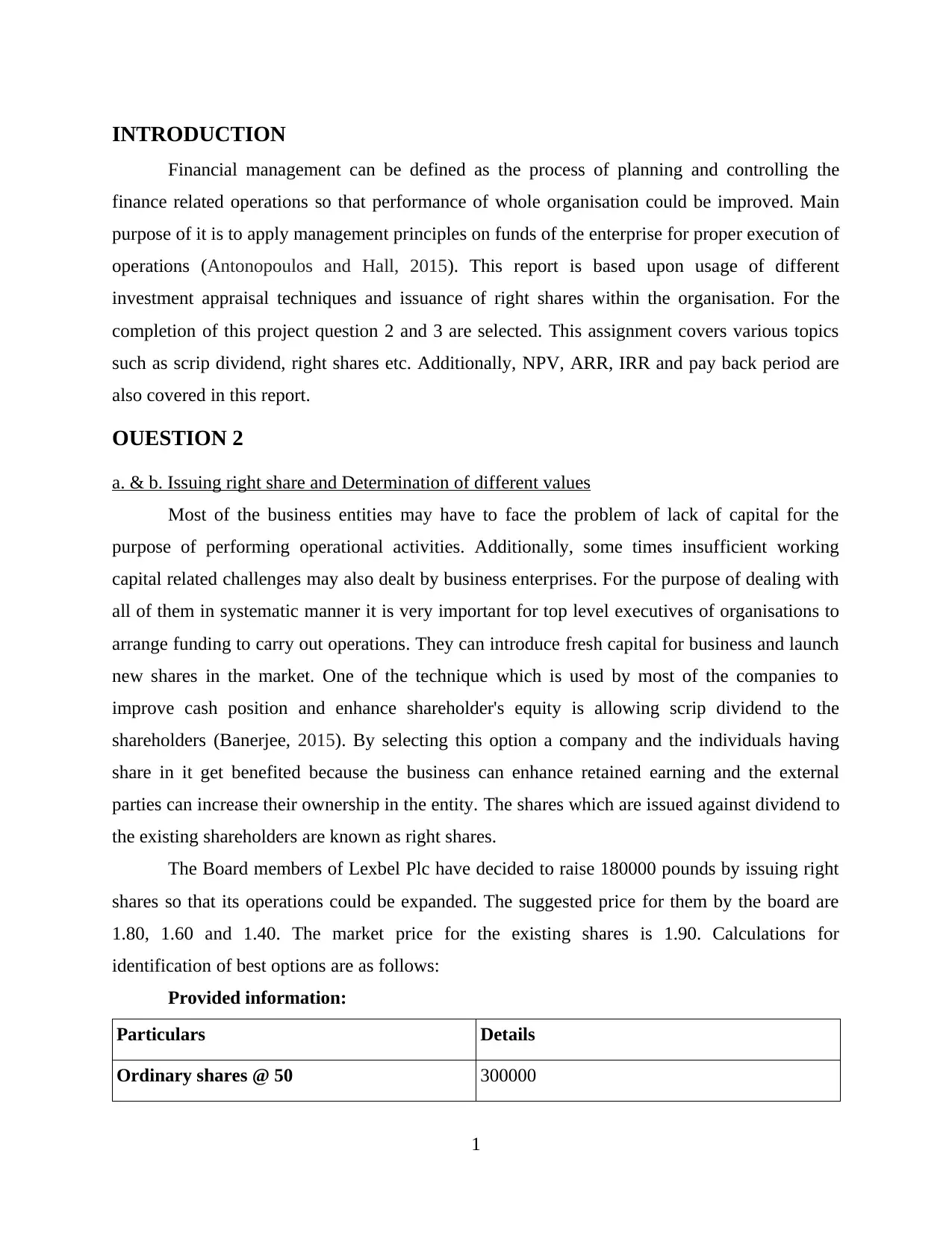
INTRODUCTION
Financial management can be defined as the process of planning and controlling the
finance related operations so that performance of whole organisation could be improved. Main
purpose of it is to apply management principles on funds of the enterprise for proper execution of
operations (Antonopoulos and Hall, 2015). This report is based upon usage of different
investment appraisal techniques and issuance of right shares within the organisation. For the
completion of this project question 2 and 3 are selected. This assignment covers various topics
such as scrip dividend, right shares etc. Additionally, NPV, ARR, IRR and pay back period are
also covered in this report.
OUESTION 2
a. & b. Issuing right share and Determination of different values
Most of the business entities may have to face the problem of lack of capital for the
purpose of performing operational activities. Additionally, some times insufficient working
capital related challenges may also dealt by business enterprises. For the purpose of dealing with
all of them in systematic manner it is very important for top level executives of organisations to
arrange funding to carry out operations. They can introduce fresh capital for business and launch
new shares in the market. One of the technique which is used by most of the companies to
improve cash position and enhance shareholder's equity is allowing scrip dividend to the
shareholders (Banerjee, 2015). By selecting this option a company and the individuals having
share in it get benefited because the business can enhance retained earning and the external
parties can increase their ownership in the entity. The shares which are issued against dividend to
the existing shareholders are known as right shares.
The Board members of Lexbel Plc have decided to raise 180000 pounds by issuing right
shares so that its operations could be expanded. The suggested price for them by the board are
1.80, 1.60 and 1.40. The market price for the existing shares is 1.90. Calculations for
identification of best options are as follows:
Provided information:
Particulars Details
Ordinary shares @ 50 300000
1
Financial management can be defined as the process of planning and controlling the
finance related operations so that performance of whole organisation could be improved. Main
purpose of it is to apply management principles on funds of the enterprise for proper execution of
operations (Antonopoulos and Hall, 2015). This report is based upon usage of different
investment appraisal techniques and issuance of right shares within the organisation. For the
completion of this project question 2 and 3 are selected. This assignment covers various topics
such as scrip dividend, right shares etc. Additionally, NPV, ARR, IRR and pay back period are
also covered in this report.
OUESTION 2
a. & b. Issuing right share and Determination of different values
Most of the business entities may have to face the problem of lack of capital for the
purpose of performing operational activities. Additionally, some times insufficient working
capital related challenges may also dealt by business enterprises. For the purpose of dealing with
all of them in systematic manner it is very important for top level executives of organisations to
arrange funding to carry out operations. They can introduce fresh capital for business and launch
new shares in the market. One of the technique which is used by most of the companies to
improve cash position and enhance shareholder's equity is allowing scrip dividend to the
shareholders (Banerjee, 2015). By selecting this option a company and the individuals having
share in it get benefited because the business can enhance retained earning and the external
parties can increase their ownership in the entity. The shares which are issued against dividend to
the existing shareholders are known as right shares.
The Board members of Lexbel Plc have decided to raise 180000 pounds by issuing right
shares so that its operations could be expanded. The suggested price for them by the board are
1.80, 1.60 and 1.40. The market price for the existing shares is 1.90. Calculations for
identification of best options are as follows:
Provided information:
Particulars Details
Ordinary shares @ 50 300000
1
⊘ This is a preview!⊘
Do you want full access?
Subscribe today to unlock all pages.

Trusted by 1+ million students worldwide
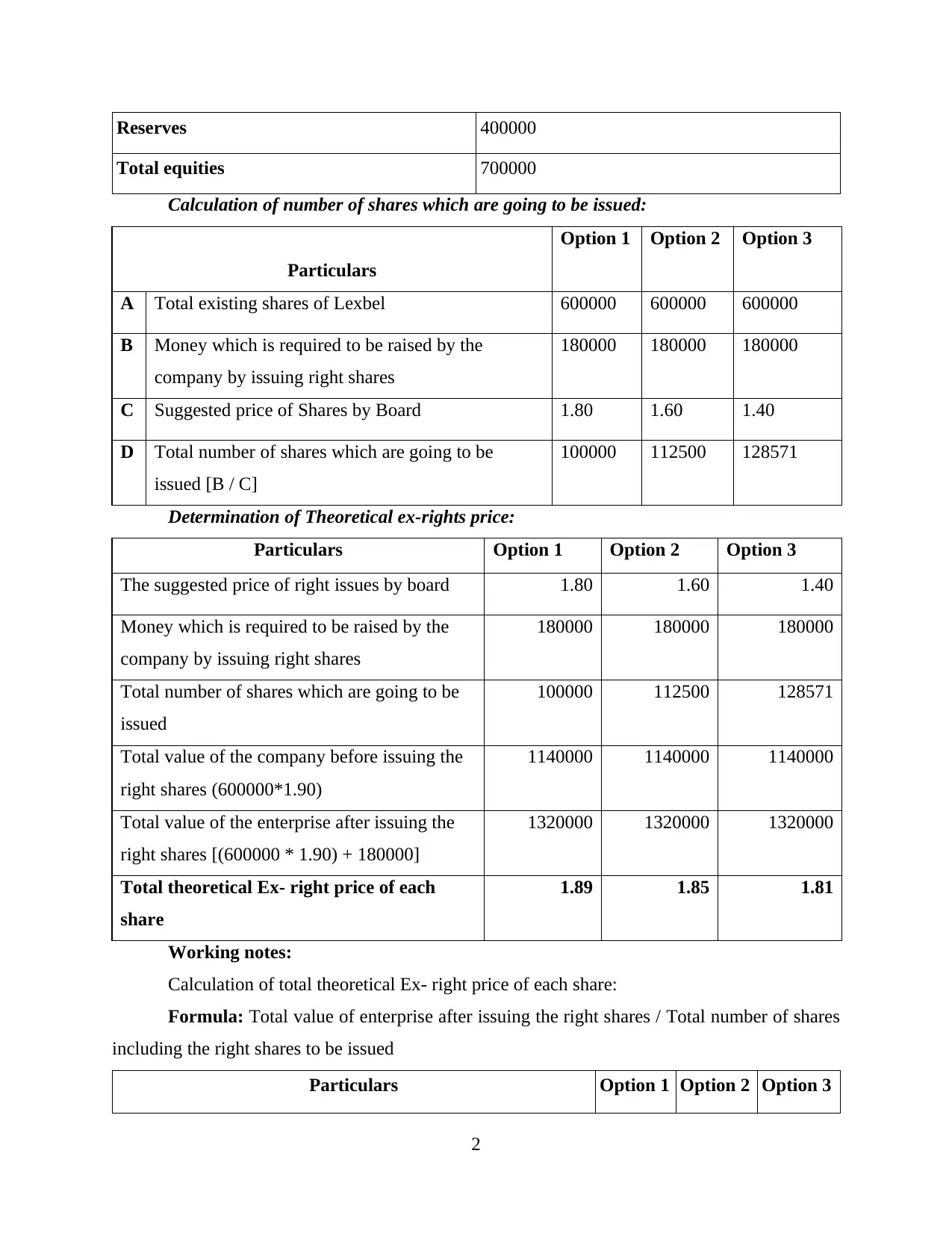
Reserves 400000
Total equities 700000
Calculation of number of shares which are going to be issued:
Particulars
Option 1 Option 2 Option 3
A Total existing shares of Lexbel 600000 600000 600000
B Money which is required to be raised by the
company by issuing right shares
180000 180000 180000
C Suggested price of Shares by Board 1.80 1.60 1.40
D Total number of shares which are going to be
issued [B / C]
100000 112500 128571
Determination of Theoretical ex-rights price:
Particulars Option 1 Option 2 Option 3
The suggested price of right issues by board 1.80 1.60 1.40
Money which is required to be raised by the
company by issuing right shares
180000 180000 180000
Total number of shares which are going to be
issued
100000 112500 128571
Total value of the company before issuing the
right shares (600000*1.90)
1140000 1140000 1140000
Total value of the enterprise after issuing the
right shares [(600000 * 1.90) + 180000]
1320000 1320000 1320000
Total theoretical Ex- right price of each
share
1.89 1.85 1.81
Working notes:
Calculation of total theoretical Ex- right price of each share:
Formula: Total value of enterprise after issuing the right shares / Total number of shares
including the right shares to be issued
Particulars Option 1 Option 2 Option 3
2
Total equities 700000
Calculation of number of shares which are going to be issued:
Particulars
Option 1 Option 2 Option 3
A Total existing shares of Lexbel 600000 600000 600000
B Money which is required to be raised by the
company by issuing right shares
180000 180000 180000
C Suggested price of Shares by Board 1.80 1.60 1.40
D Total number of shares which are going to be
issued [B / C]
100000 112500 128571
Determination of Theoretical ex-rights price:
Particulars Option 1 Option 2 Option 3
The suggested price of right issues by board 1.80 1.60 1.40
Money which is required to be raised by the
company by issuing right shares
180000 180000 180000
Total number of shares which are going to be
issued
100000 112500 128571
Total value of the company before issuing the
right shares (600000*1.90)
1140000 1140000 1140000
Total value of the enterprise after issuing the
right shares [(600000 * 1.90) + 180000]
1320000 1320000 1320000
Total theoretical Ex- right price of each
share
1.89 1.85 1.81
Working notes:
Calculation of total theoretical Ex- right price of each share:
Formula: Total value of enterprise after issuing the right shares / Total number of shares
including the right shares to be issued
Particulars Option 1 Option 2 Option 3
2
Paraphrase This Document
Need a fresh take? Get an instant paraphrase of this document with our AI Paraphraser
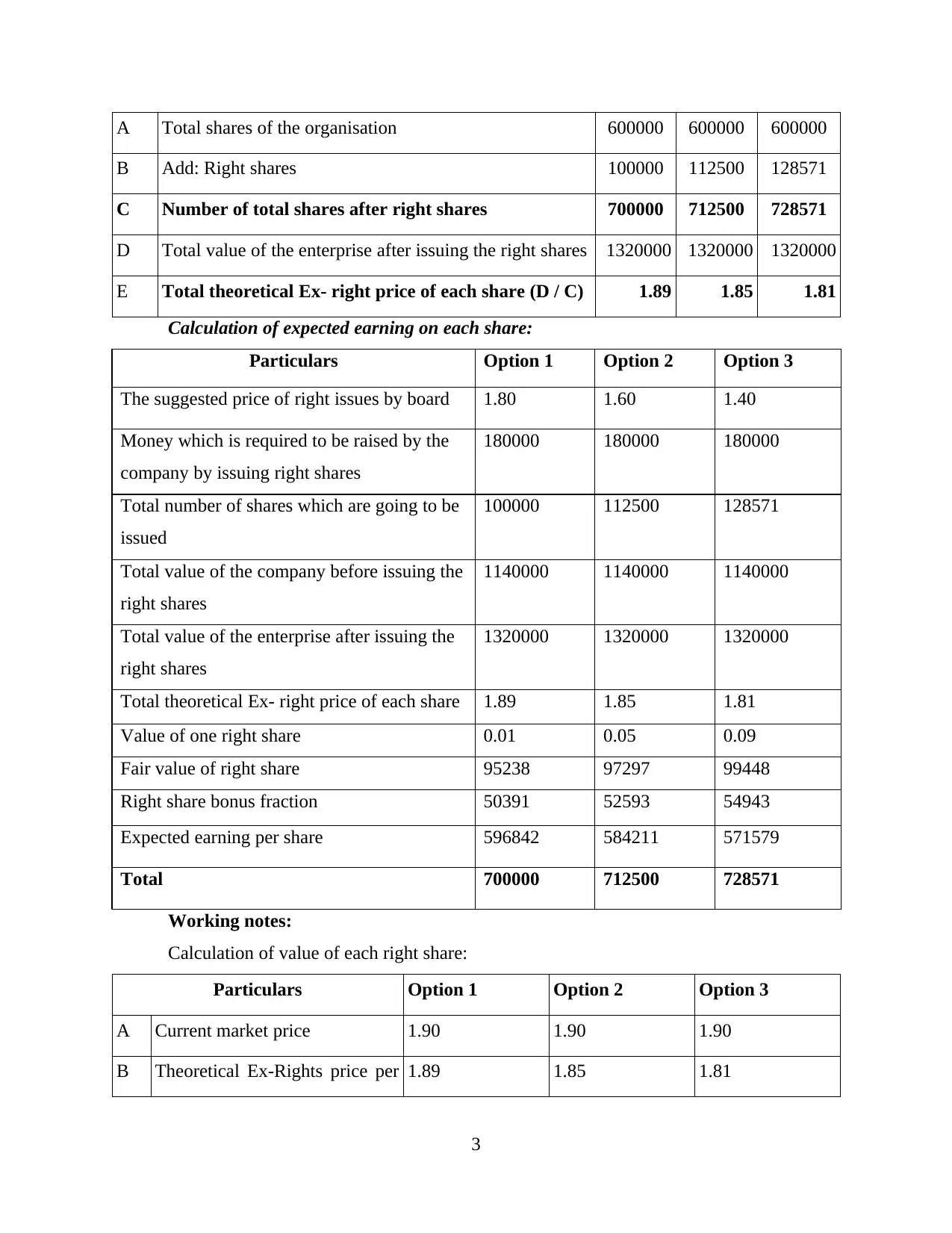
A Total shares of the organisation 600000 600000 600000
B Add: Right shares 100000 112500 128571
C Number of total shares after right shares 700000 712500 728571
D Total value of the enterprise after issuing the right shares 1320000 1320000 1320000
E Total theoretical Ex- right price of each share (D / C) 1.89 1.85 1.81
Calculation of expected earning on each share:
Particulars Option 1 Option 2 Option 3
The suggested price of right issues by board 1.80 1.60 1.40
Money which is required to be raised by the
company by issuing right shares
180000 180000 180000
Total number of shares which are going to be
issued
100000 112500 128571
Total value of the company before issuing the
right shares
1140000 1140000 1140000
Total value of the enterprise after issuing the
right shares
1320000 1320000 1320000
Total theoretical Ex- right price of each share 1.89 1.85 1.81
Value of one right share 0.01 0.05 0.09
Fair value of right share 95238 97297 99448
Right share bonus fraction 50391 52593 54943
Expected earning per share 596842 584211 571579
Total 700000 712500 728571
Working notes:
Calculation of value of each right share:
Particulars Option 1 Option 2 Option 3
A Current market price 1.90 1.90 1.90
B Theoretical Ex-Rights price per 1.89 1.85 1.81
3
B Add: Right shares 100000 112500 128571
C Number of total shares after right shares 700000 712500 728571
D Total value of the enterprise after issuing the right shares 1320000 1320000 1320000
E Total theoretical Ex- right price of each share (D / C) 1.89 1.85 1.81
Calculation of expected earning on each share:
Particulars Option 1 Option 2 Option 3
The suggested price of right issues by board 1.80 1.60 1.40
Money which is required to be raised by the
company by issuing right shares
180000 180000 180000
Total number of shares which are going to be
issued
100000 112500 128571
Total value of the company before issuing the
right shares
1140000 1140000 1140000
Total value of the enterprise after issuing the
right shares
1320000 1320000 1320000
Total theoretical Ex- right price of each share 1.89 1.85 1.81
Value of one right share 0.01 0.05 0.09
Fair value of right share 95238 97297 99448
Right share bonus fraction 50391 52593 54943
Expected earning per share 596842 584211 571579
Total 700000 712500 728571
Working notes:
Calculation of value of each right share:
Particulars Option 1 Option 2 Option 3
A Current market price 1.90 1.90 1.90
B Theoretical Ex-Rights price per 1.89 1.85 1.81
3
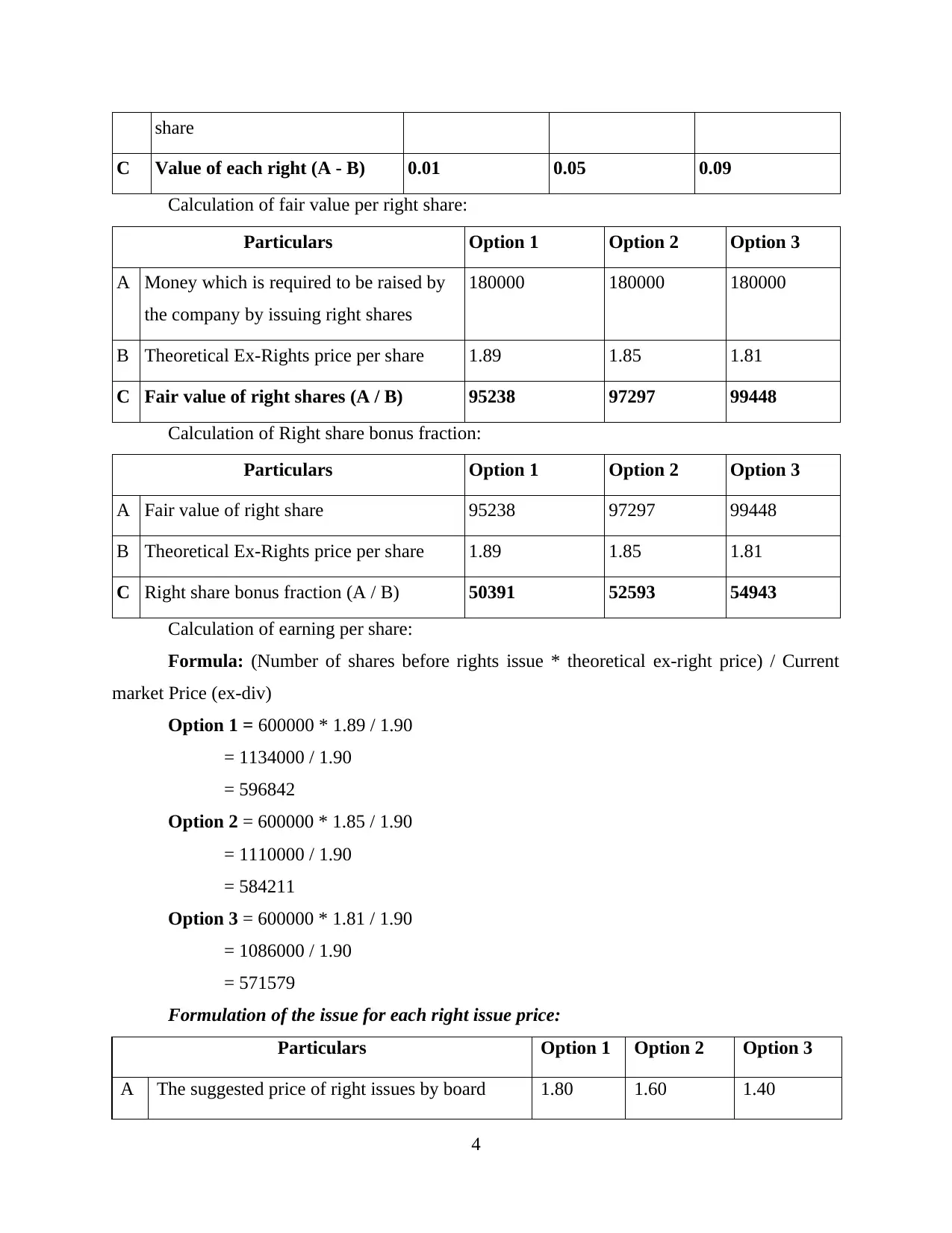
share
C Value of each right (A - B) 0.01 0.05 0.09
Calculation of fair value per right share:
Particulars Option 1 Option 2 Option 3
A Money which is required to be raised by
the company by issuing right shares
180000 180000 180000
B Theoretical Ex-Rights price per share 1.89 1.85 1.81
C Fair value of right shares (A / B) 95238 97297 99448
Calculation of Right share bonus fraction:
Particulars Option 1 Option 2 Option 3
A Fair value of right share 95238 97297 99448
B Theoretical Ex-Rights price per share 1.89 1.85 1.81
C Right share bonus fraction (A / B) 50391 52593 54943
Calculation of earning per share:
Formula: (Number of shares before rights issue * theoretical ex-right price) / Current
market Price (ex-div)
Option 1 = 600000 * 1.89 / 1.90
= 1134000 / 1.90
= 596842
Option 2 = 600000 * 1.85 / 1.90
= 1110000 / 1.90
= 584211
Option 3 = 600000 * 1.81 / 1.90
= 1086000 / 1.90
= 571579
Formulation of the issue for each right issue price:
Particulars Option 1 Option 2 Option 3
A The suggested price of right issues by board 1.80 1.60 1.40
4
C Value of each right (A - B) 0.01 0.05 0.09
Calculation of fair value per right share:
Particulars Option 1 Option 2 Option 3
A Money which is required to be raised by
the company by issuing right shares
180000 180000 180000
B Theoretical Ex-Rights price per share 1.89 1.85 1.81
C Fair value of right shares (A / B) 95238 97297 99448
Calculation of Right share bonus fraction:
Particulars Option 1 Option 2 Option 3
A Fair value of right share 95238 97297 99448
B Theoretical Ex-Rights price per share 1.89 1.85 1.81
C Right share bonus fraction (A / B) 50391 52593 54943
Calculation of earning per share:
Formula: (Number of shares before rights issue * theoretical ex-right price) / Current
market Price (ex-div)
Option 1 = 600000 * 1.89 / 1.90
= 1134000 / 1.90
= 596842
Option 2 = 600000 * 1.85 / 1.90
= 1110000 / 1.90
= 584211
Option 3 = 600000 * 1.81 / 1.90
= 1086000 / 1.90
= 571579
Formulation of the issue for each right issue price:
Particulars Option 1 Option 2 Option 3
A The suggested price of right issues by board 1.80 1.60 1.40
4
⊘ This is a preview!⊘
Do you want full access?
Subscribe today to unlock all pages.

Trusted by 1+ million students worldwide
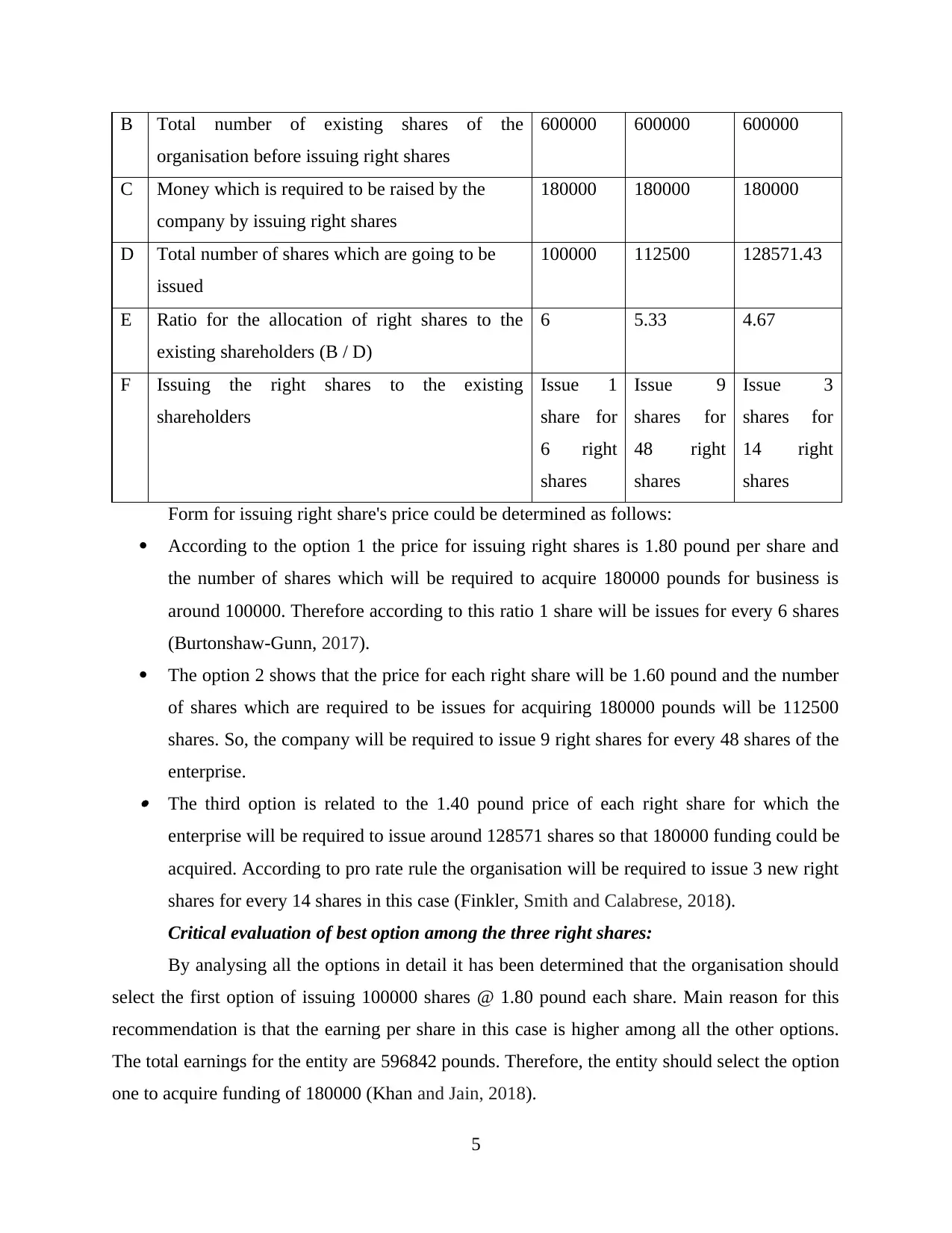
B Total number of existing shares of the
organisation before issuing right shares
600000 600000 600000
C Money which is required to be raised by the
company by issuing right shares
180000 180000 180000
D Total number of shares which are going to be
issued
100000 112500 128571.43
E Ratio for the allocation of right shares to the
existing shareholders (B / D)
6 5.33 4.67
F Issuing the right shares to the existing
shareholders
Issue 1
share for
6 right
shares
Issue 9
shares for
48 right
shares
Issue 3
shares for
14 right
shares
Form for issuing right share's price could be determined as follows:
According to the option 1 the price for issuing right shares is 1.80 pound per share and
the number of shares which will be required to acquire 180000 pounds for business is
around 100000. Therefore according to this ratio 1 share will be issues for every 6 shares
(Burtonshaw-Gunn, 2017).
The option 2 shows that the price for each right share will be 1.60 pound and the number
of shares which are required to be issues for acquiring 180000 pounds will be 112500
shares. So, the company will be required to issue 9 right shares for every 48 shares of the
enterprise. The third option is related to the 1.40 pound price of each right share for which the
enterprise will be required to issue around 128571 shares so that 180000 funding could be
acquired. According to pro rate rule the organisation will be required to issue 3 new right
shares for every 14 shares in this case (Finkler, Smith and Calabrese, 2018).
Critical evaluation of best option among the three right shares:
By analysing all the options in detail it has been determined that the organisation should
select the first option of issuing 100000 shares @ 1.80 pound each share. Main reason for this
recommendation is that the earning per share in this case is higher among all the other options.
The total earnings for the entity are 596842 pounds. Therefore, the entity should select the option
one to acquire funding of 180000 (Khan and Jain, 2018).
5
organisation before issuing right shares
600000 600000 600000
C Money which is required to be raised by the
company by issuing right shares
180000 180000 180000
D Total number of shares which are going to be
issued
100000 112500 128571.43
E Ratio for the allocation of right shares to the
existing shareholders (B / D)
6 5.33 4.67
F Issuing the right shares to the existing
shareholders
Issue 1
share for
6 right
shares
Issue 9
shares for
48 right
shares
Issue 3
shares for
14 right
shares
Form for issuing right share's price could be determined as follows:
According to the option 1 the price for issuing right shares is 1.80 pound per share and
the number of shares which will be required to acquire 180000 pounds for business is
around 100000. Therefore according to this ratio 1 share will be issues for every 6 shares
(Burtonshaw-Gunn, 2017).
The option 2 shows that the price for each right share will be 1.60 pound and the number
of shares which are required to be issues for acquiring 180000 pounds will be 112500
shares. So, the company will be required to issue 9 right shares for every 48 shares of the
enterprise. The third option is related to the 1.40 pound price of each right share for which the
enterprise will be required to issue around 128571 shares so that 180000 funding could be
acquired. According to pro rate rule the organisation will be required to issue 3 new right
shares for every 14 shares in this case (Finkler, Smith and Calabrese, 2018).
Critical evaluation of best option among the three right shares:
By analysing all the options in detail it has been determined that the organisation should
select the first option of issuing 100000 shares @ 1.80 pound each share. Main reason for this
recommendation is that the earning per share in this case is higher among all the other options.
The total earnings for the entity are 596842 pounds. Therefore, the entity should select the option
one to acquire funding of 180000 (Khan and Jain, 2018).
5
Paraphrase This Document
Need a fresh take? Get an instant paraphrase of this document with our AI Paraphraser
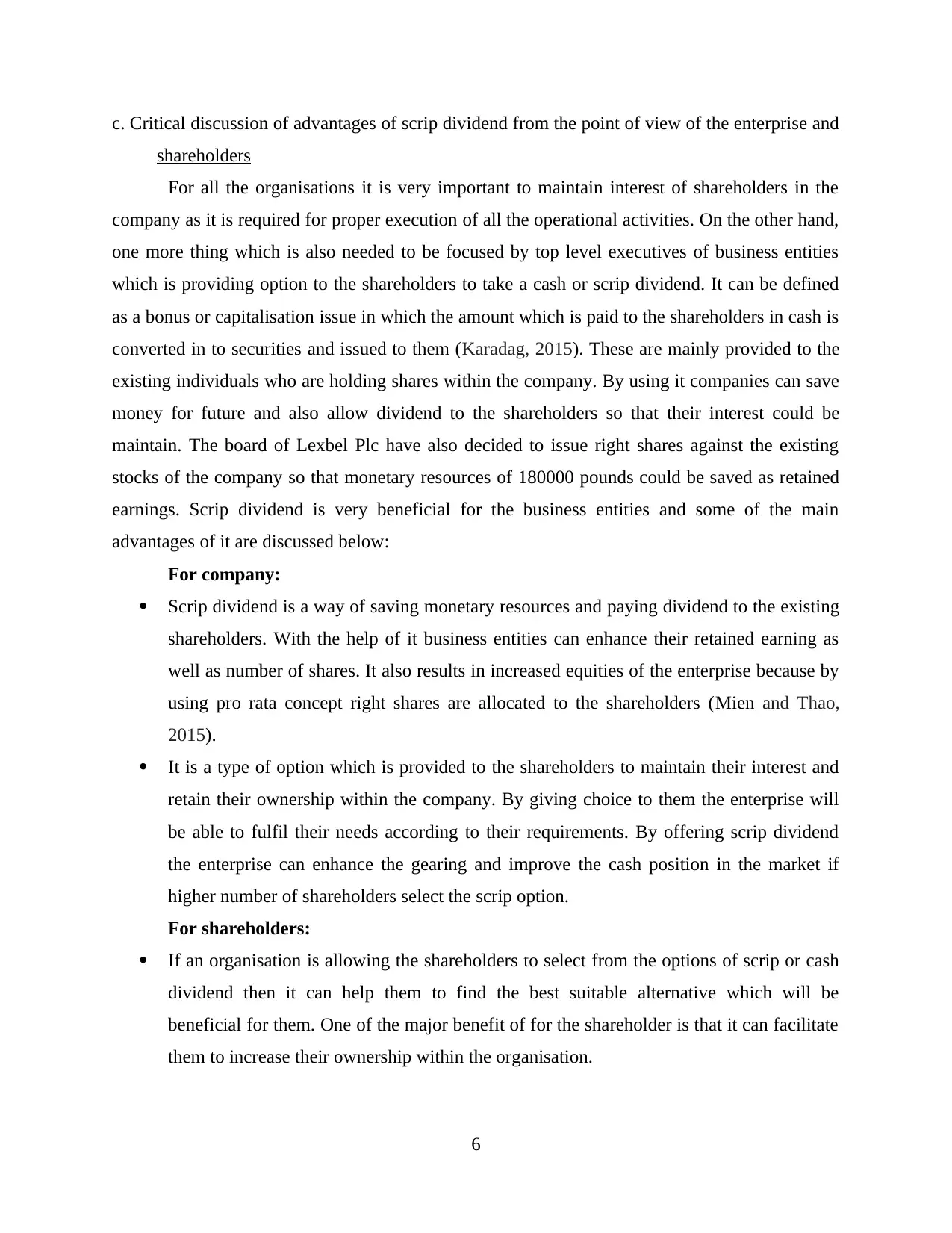
c. Critical discussion of advantages of scrip dividend from the point of view of the enterprise and
shareholders
For all the organisations it is very important to maintain interest of shareholders in the
company as it is required for proper execution of all the operational activities. On the other hand,
one more thing which is also needed to be focused by top level executives of business entities
which is providing option to the shareholders to take a cash or scrip dividend. It can be defined
as a bonus or capitalisation issue in which the amount which is paid to the shareholders in cash is
converted in to securities and issued to them (Karadag, 2015). These are mainly provided to the
existing individuals who are holding shares within the company. By using it companies can save
money for future and also allow dividend to the shareholders so that their interest could be
maintain. The board of Lexbel Plc have also decided to issue right shares against the existing
stocks of the company so that monetary resources of 180000 pounds could be saved as retained
earnings. Scrip dividend is very beneficial for the business entities and some of the main
advantages of it are discussed below:
For company:
Scrip dividend is a way of saving monetary resources and paying dividend to the existing
shareholders. With the help of it business entities can enhance their retained earning as
well as number of shares. It also results in increased equities of the enterprise because by
using pro rata concept right shares are allocated to the shareholders (Mien and Thao,
2015).
It is a type of option which is provided to the shareholders to maintain their interest and
retain their ownership within the company. By giving choice to them the enterprise will
be able to fulfil their needs according to their requirements. By offering scrip dividend
the enterprise can enhance the gearing and improve the cash position in the market if
higher number of shareholders select the scrip option.
For shareholders:
If an organisation is allowing the shareholders to select from the options of scrip or cash
dividend then it can help them to find the best suitable alternative which will be
beneficial for them. One of the major benefit of for the shareholder is that it can facilitate
them to increase their ownership within the organisation.
6
shareholders
For all the organisations it is very important to maintain interest of shareholders in the
company as it is required for proper execution of all the operational activities. On the other hand,
one more thing which is also needed to be focused by top level executives of business entities
which is providing option to the shareholders to take a cash or scrip dividend. It can be defined
as a bonus or capitalisation issue in which the amount which is paid to the shareholders in cash is
converted in to securities and issued to them (Karadag, 2015). These are mainly provided to the
existing individuals who are holding shares within the company. By using it companies can save
money for future and also allow dividend to the shareholders so that their interest could be
maintain. The board of Lexbel Plc have also decided to issue right shares against the existing
stocks of the company so that monetary resources of 180000 pounds could be saved as retained
earnings. Scrip dividend is very beneficial for the business entities and some of the main
advantages of it are discussed below:
For company:
Scrip dividend is a way of saving monetary resources and paying dividend to the existing
shareholders. With the help of it business entities can enhance their retained earning as
well as number of shares. It also results in increased equities of the enterprise because by
using pro rata concept right shares are allocated to the shareholders (Mien and Thao,
2015).
It is a type of option which is provided to the shareholders to maintain their interest and
retain their ownership within the company. By giving choice to them the enterprise will
be able to fulfil their needs according to their requirements. By offering scrip dividend
the enterprise can enhance the gearing and improve the cash position in the market if
higher number of shareholders select the scrip option.
For shareholders:
If an organisation is allowing the shareholders to select from the options of scrip or cash
dividend then it can help them to find the best suitable alternative which will be
beneficial for them. One of the major benefit of for the shareholder is that it can facilitate
them to increase their ownership within the organisation.
6
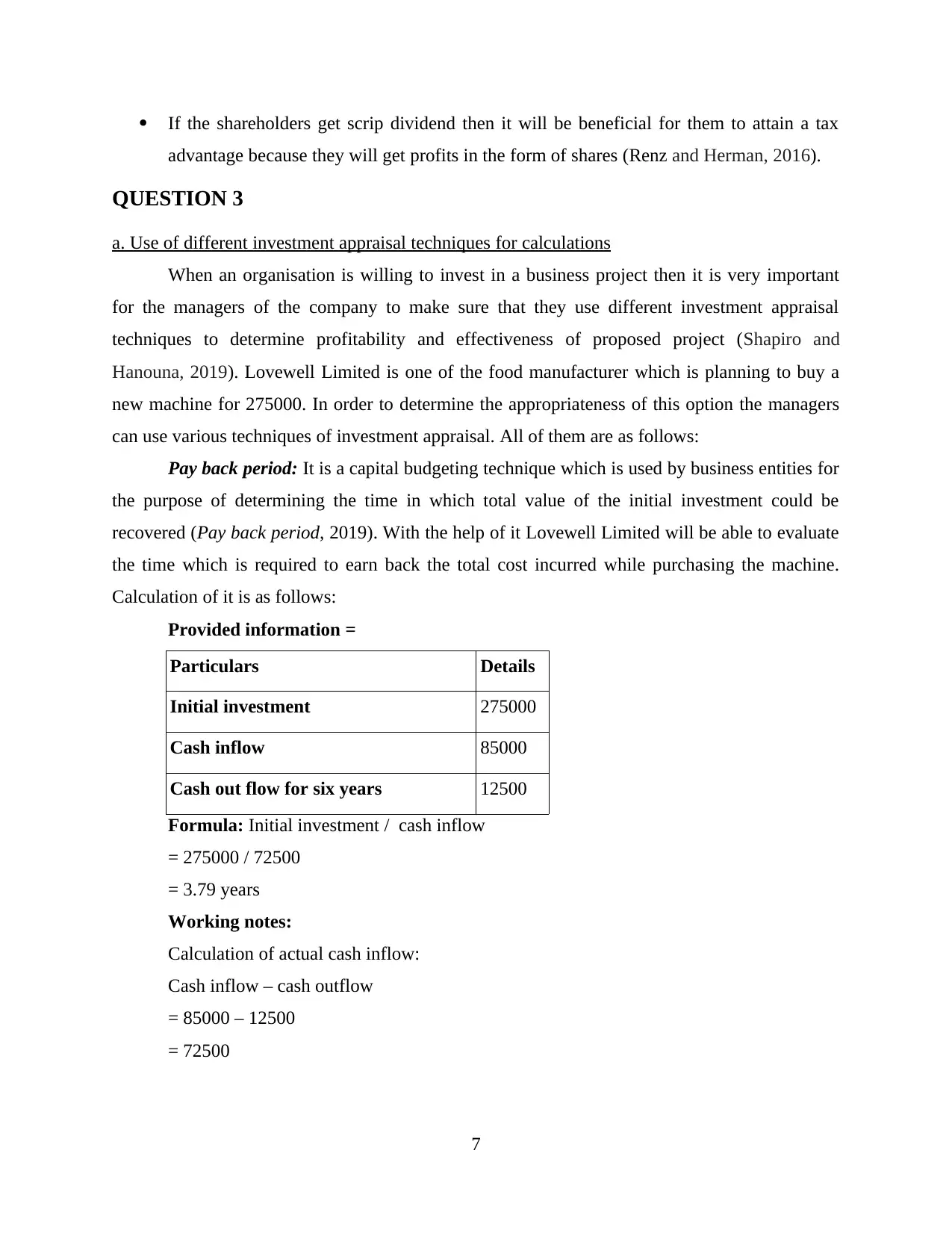
If the shareholders get scrip dividend then it will be beneficial for them to attain a tax
advantage because they will get profits in the form of shares (Renz and Herman, 2016).
QUESTION 3
a. Use of different investment appraisal techniques for calculations
When an organisation is willing to invest in a business project then it is very important
for the managers of the company to make sure that they use different investment appraisal
techniques to determine profitability and effectiveness of proposed project (Shapiro and
Hanouna, 2019). Lovewell Limited is one of the food manufacturer which is planning to buy a
new machine for 275000. In order to determine the appropriateness of this option the managers
can use various techniques of investment appraisal. All of them are as follows:
Pay back period: It is a capital budgeting technique which is used by business entities for
the purpose of determining the time in which total value of the initial investment could be
recovered (Pay back period, 2019). With the help of it Lovewell Limited will be able to evaluate
the time which is required to earn back the total cost incurred while purchasing the machine.
Calculation of it is as follows:
Provided information =
Particulars Details
Initial investment 275000
Cash inflow 85000
Cash out flow for six years 12500
Formula: Initial investment / cash inflow
= 275000 / 72500
= 3.79 years
Working notes:
Calculation of actual cash inflow:
Cash inflow – cash outflow
= 85000 – 12500
= 72500
7
advantage because they will get profits in the form of shares (Renz and Herman, 2016).
QUESTION 3
a. Use of different investment appraisal techniques for calculations
When an organisation is willing to invest in a business project then it is very important
for the managers of the company to make sure that they use different investment appraisal
techniques to determine profitability and effectiveness of proposed project (Shapiro and
Hanouna, 2019). Lovewell Limited is one of the food manufacturer which is planning to buy a
new machine for 275000. In order to determine the appropriateness of this option the managers
can use various techniques of investment appraisal. All of them are as follows:
Pay back period: It is a capital budgeting technique which is used by business entities for
the purpose of determining the time in which total value of the initial investment could be
recovered (Pay back period, 2019). With the help of it Lovewell Limited will be able to evaluate
the time which is required to earn back the total cost incurred while purchasing the machine.
Calculation of it is as follows:
Provided information =
Particulars Details
Initial investment 275000
Cash inflow 85000
Cash out flow for six years 12500
Formula: Initial investment / cash inflow
= 275000 / 72500
= 3.79 years
Working notes:
Calculation of actual cash inflow:
Cash inflow – cash outflow
= 85000 – 12500
= 72500
7
⊘ This is a preview!⊘
Do you want full access?
Subscribe today to unlock all pages.

Trusted by 1+ million students worldwide
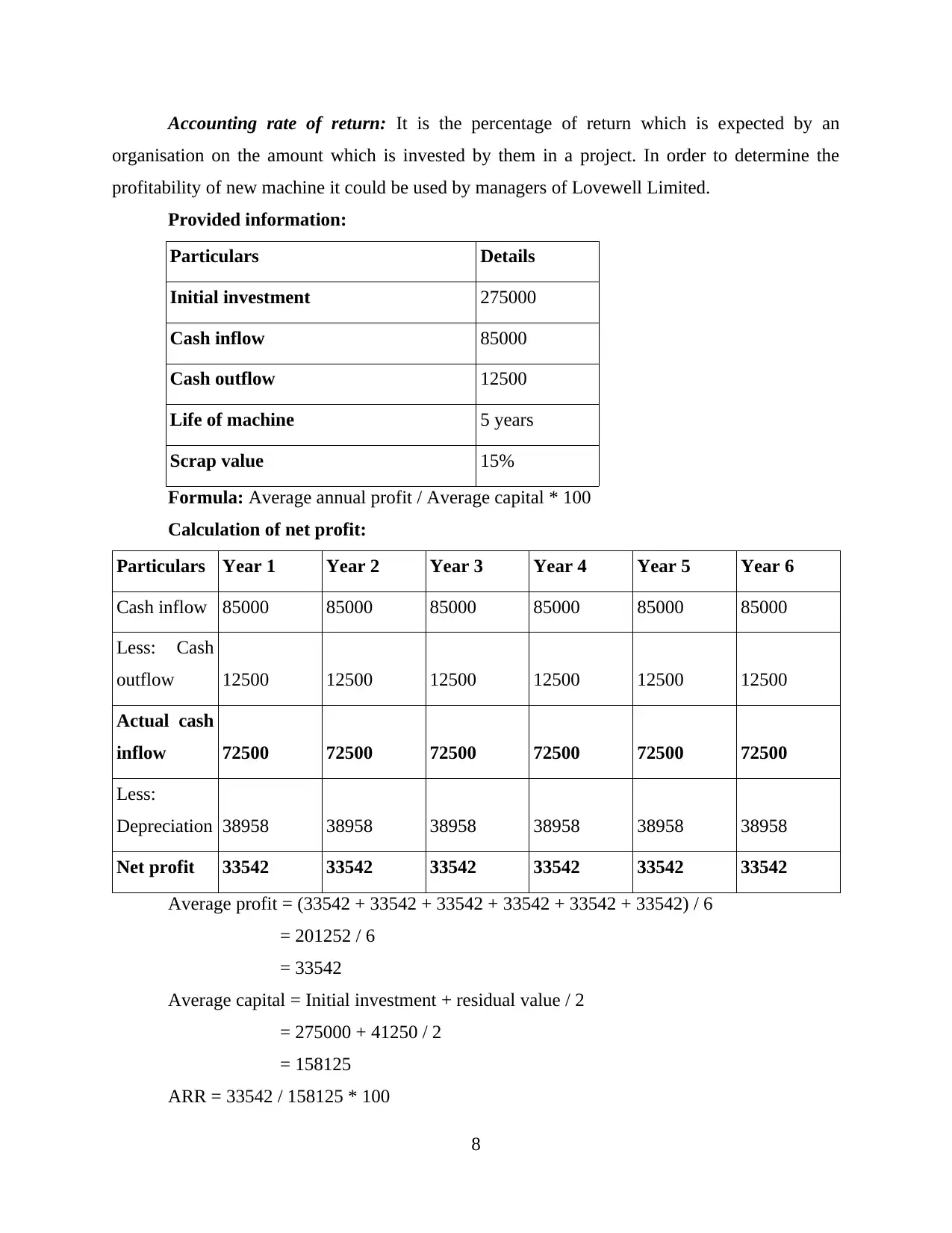
Accounting rate of return: It is the percentage of return which is expected by an
organisation on the amount which is invested by them in a project. In order to determine the
profitability of new machine it could be used by managers of Lovewell Limited.
Provided information:
Particulars Details
Initial investment 275000
Cash inflow 85000
Cash outflow 12500
Life of machine 5 years
Scrap value 15%
Formula: Average annual profit / Average capital * 100
Calculation of net profit:
Particulars Year 1 Year 2 Year 3 Year 4 Year 5 Year 6
Cash inflow 85000 85000 85000 85000 85000 85000
Less: Cash
outflow 12500 12500 12500 12500 12500 12500
Actual cash
inflow 72500 72500 72500 72500 72500 72500
Less:
Depreciation 38958 38958 38958 38958 38958 38958
Net profit 33542 33542 33542 33542 33542 33542
Average profit = (33542 + 33542 + 33542 + 33542 + 33542 + 33542) / 6
= 201252 / 6
= 33542
Average capital = Initial investment + residual value / 2
= 275000 + 41250 / 2
= 158125
ARR = 33542 / 158125 * 100
8
organisation on the amount which is invested by them in a project. In order to determine the
profitability of new machine it could be used by managers of Lovewell Limited.
Provided information:
Particulars Details
Initial investment 275000
Cash inflow 85000
Cash outflow 12500
Life of machine 5 years
Scrap value 15%
Formula: Average annual profit / Average capital * 100
Calculation of net profit:
Particulars Year 1 Year 2 Year 3 Year 4 Year 5 Year 6
Cash inflow 85000 85000 85000 85000 85000 85000
Less: Cash
outflow 12500 12500 12500 12500 12500 12500
Actual cash
inflow 72500 72500 72500 72500 72500 72500
Less:
Depreciation 38958 38958 38958 38958 38958 38958
Net profit 33542 33542 33542 33542 33542 33542
Average profit = (33542 + 33542 + 33542 + 33542 + 33542 + 33542) / 6
= 201252 / 6
= 33542
Average capital = Initial investment + residual value / 2
= 275000 + 41250 / 2
= 158125
ARR = 33542 / 158125 * 100
8
Paraphrase This Document
Need a fresh take? Get an instant paraphrase of this document with our AI Paraphraser
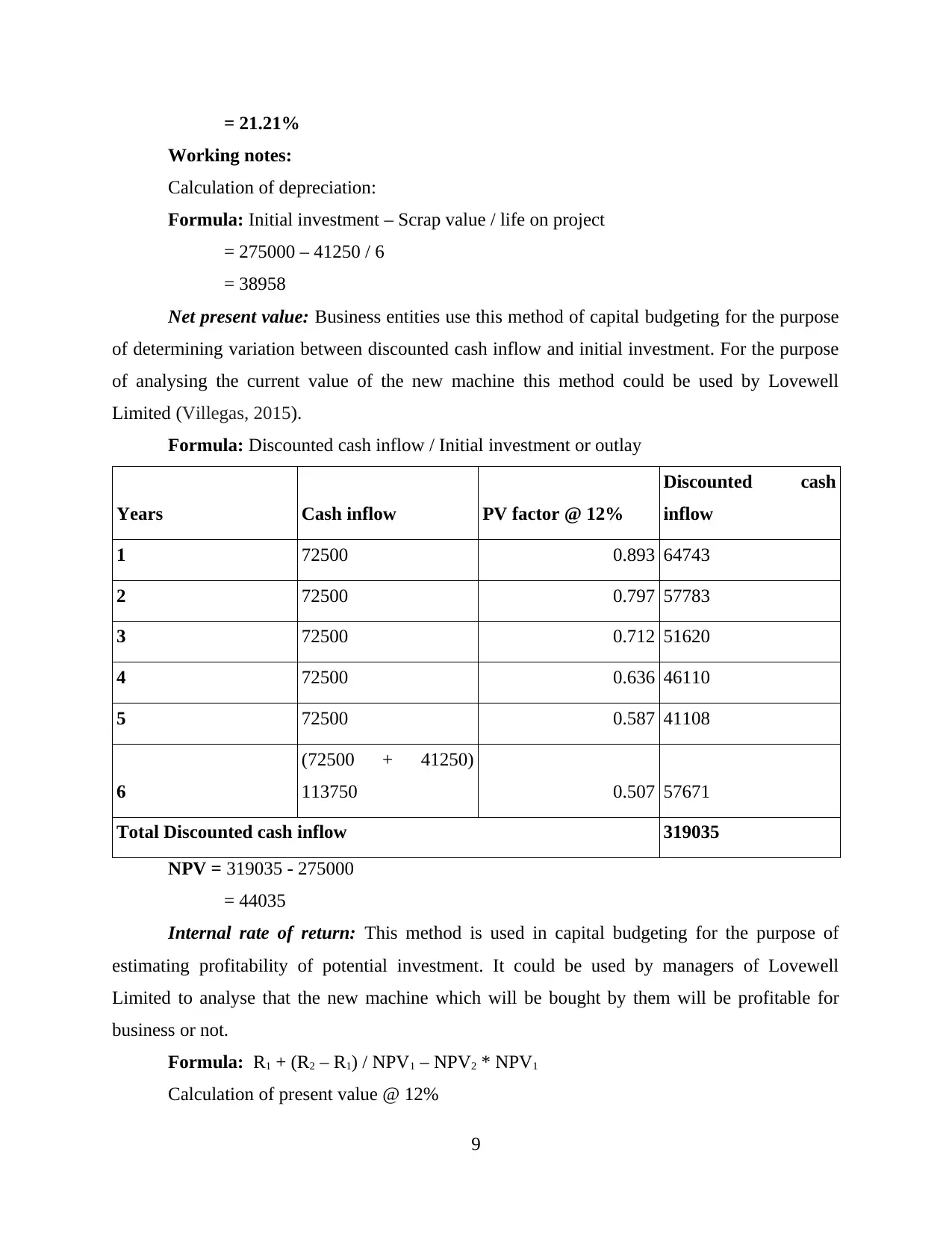
= 21.21%
Working notes:
Calculation of depreciation:
Formula: Initial investment – Scrap value / life on project
= 275000 – 41250 / 6
= 38958
Net present value: Business entities use this method of capital budgeting for the purpose
of determining variation between discounted cash inflow and initial investment. For the purpose
of analysing the current value of the new machine this method could be used by Lovewell
Limited (Villegas, 2015).
Formula: Discounted cash inflow / Initial investment or outlay
Years Cash inflow PV factor @ 12%
Discounted cash
inflow
1 72500 0.893 64743
2 72500 0.797 57783
3 72500 0.712 51620
4 72500 0.636 46110
5 72500 0.587 41108
6
(72500 + 41250)
113750 0.507 57671
Total Discounted cash inflow 319035
NPV = 319035 - 275000
= 44035
Internal rate of return: This method is used in capital budgeting for the purpose of
estimating profitability of potential investment. It could be used by managers of Lovewell
Limited to analyse that the new machine which will be bought by them will be profitable for
business or not.
Formula: R1 + (R2 – R1) / NPV1 – NPV2 * NPV1
Calculation of present value @ 12%
9
Working notes:
Calculation of depreciation:
Formula: Initial investment – Scrap value / life on project
= 275000 – 41250 / 6
= 38958
Net present value: Business entities use this method of capital budgeting for the purpose
of determining variation between discounted cash inflow and initial investment. For the purpose
of analysing the current value of the new machine this method could be used by Lovewell
Limited (Villegas, 2015).
Formula: Discounted cash inflow / Initial investment or outlay
Years Cash inflow PV factor @ 12%
Discounted cash
inflow
1 72500 0.893 64743
2 72500 0.797 57783
3 72500 0.712 51620
4 72500 0.636 46110
5 72500 0.587 41108
6
(72500 + 41250)
113750 0.507 57671
Total Discounted cash inflow 319035
NPV = 319035 - 275000
= 44035
Internal rate of return: This method is used in capital budgeting for the purpose of
estimating profitability of potential investment. It could be used by managers of Lovewell
Limited to analyse that the new machine which will be bought by them will be profitable for
business or not.
Formula: R1 + (R2 – R1) / NPV1 – NPV2 * NPV1
Calculation of present value @ 12%
9
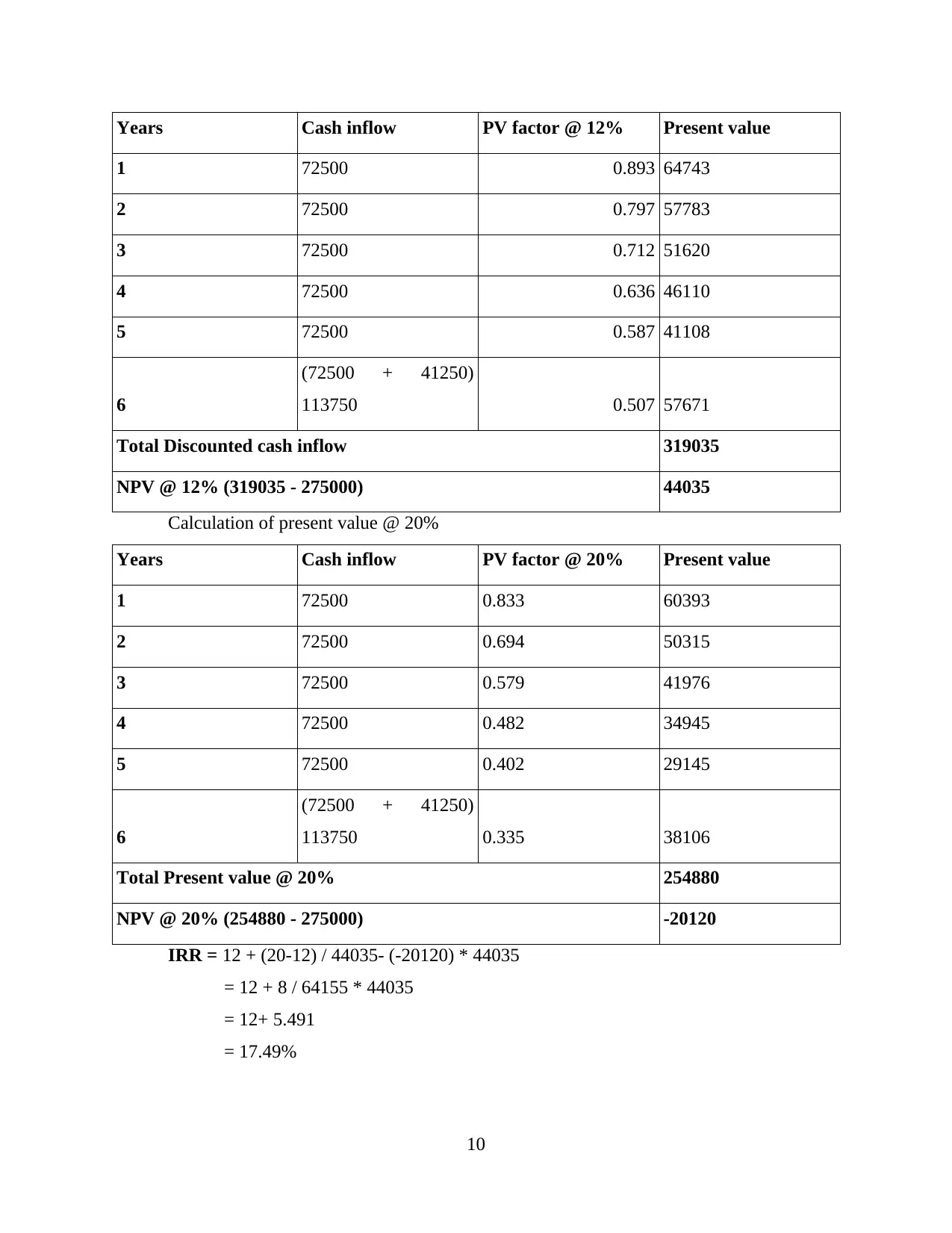
Years Cash inflow PV factor @ 12% Present value
1 72500 0.893 64743
2 72500 0.797 57783
3 72500 0.712 51620
4 72500 0.636 46110
5 72500 0.587 41108
6
(72500 + 41250)
113750 0.507 57671
Total Discounted cash inflow 319035
NPV @ 12% (319035 - 275000) 44035
Calculation of present value @ 20%
Years Cash inflow PV factor @ 20% Present value
1 72500 0.833 60393
2 72500 0.694 50315
3 72500 0.579 41976
4 72500 0.482 34945
5 72500 0.402 29145
6
(72500 + 41250)
113750 0.335 38106
Total Present value @ 20% 254880
NPV @ 20% (254880 - 275000) -20120
IRR = 12 + (20-12) / 44035- (-20120) * 44035
= 12 + 8 / 64155 * 44035
= 12+ 5.491
= 17.49%
10
1 72500 0.893 64743
2 72500 0.797 57783
3 72500 0.712 51620
4 72500 0.636 46110
5 72500 0.587 41108
6
(72500 + 41250)
113750 0.507 57671
Total Discounted cash inflow 319035
NPV @ 12% (319035 - 275000) 44035
Calculation of present value @ 20%
Years Cash inflow PV factor @ 20% Present value
1 72500 0.833 60393
2 72500 0.694 50315
3 72500 0.579 41976
4 72500 0.482 34945
5 72500 0.402 29145
6
(72500 + 41250)
113750 0.335 38106
Total Present value @ 20% 254880
NPV @ 20% (254880 - 275000) -20120
IRR = 12 + (20-12) / 44035- (-20120) * 44035
= 12 + 8 / 64155 * 44035
= 12+ 5.491
= 17.49%
10
⊘ This is a preview!⊘
Do you want full access?
Subscribe today to unlock all pages.

Trusted by 1+ million students worldwide
1 out of 15
Related Documents
Your All-in-One AI-Powered Toolkit for Academic Success.
+13062052269
info@desklib.com
Available 24*7 on WhatsApp / Email
![[object Object]](/_next/static/media/star-bottom.7253800d.svg)
Unlock your academic potential
Copyright © 2020–2025 A2Z Services. All Rights Reserved. Developed and managed by ZUCOL.





